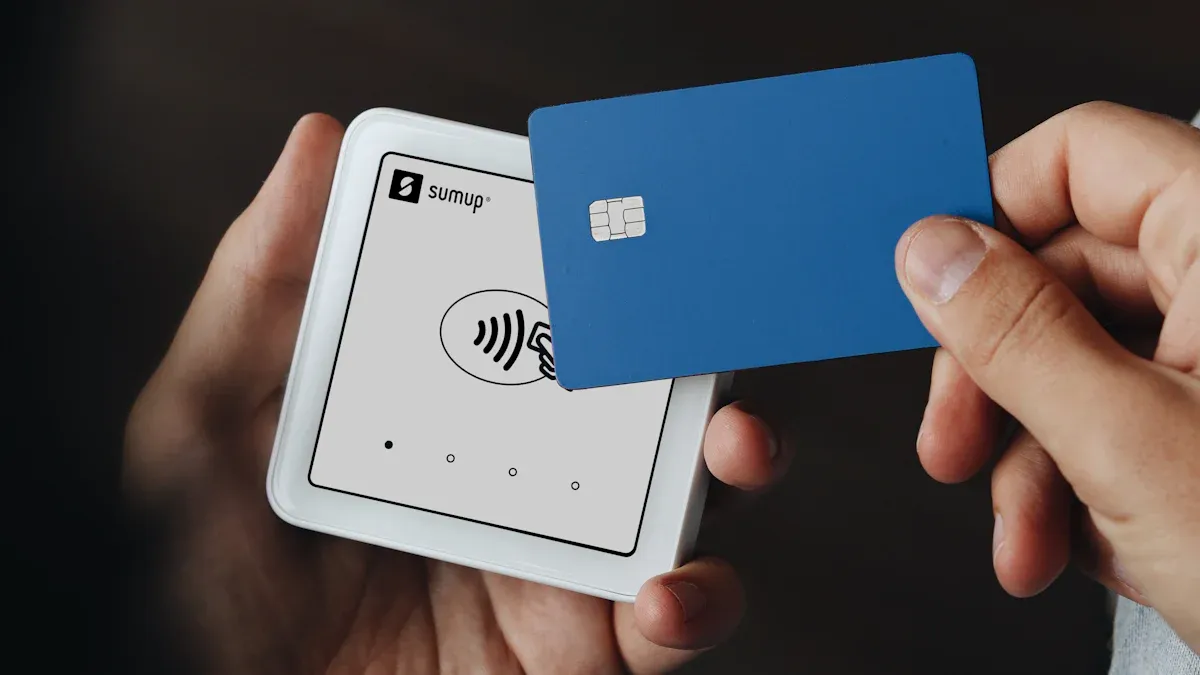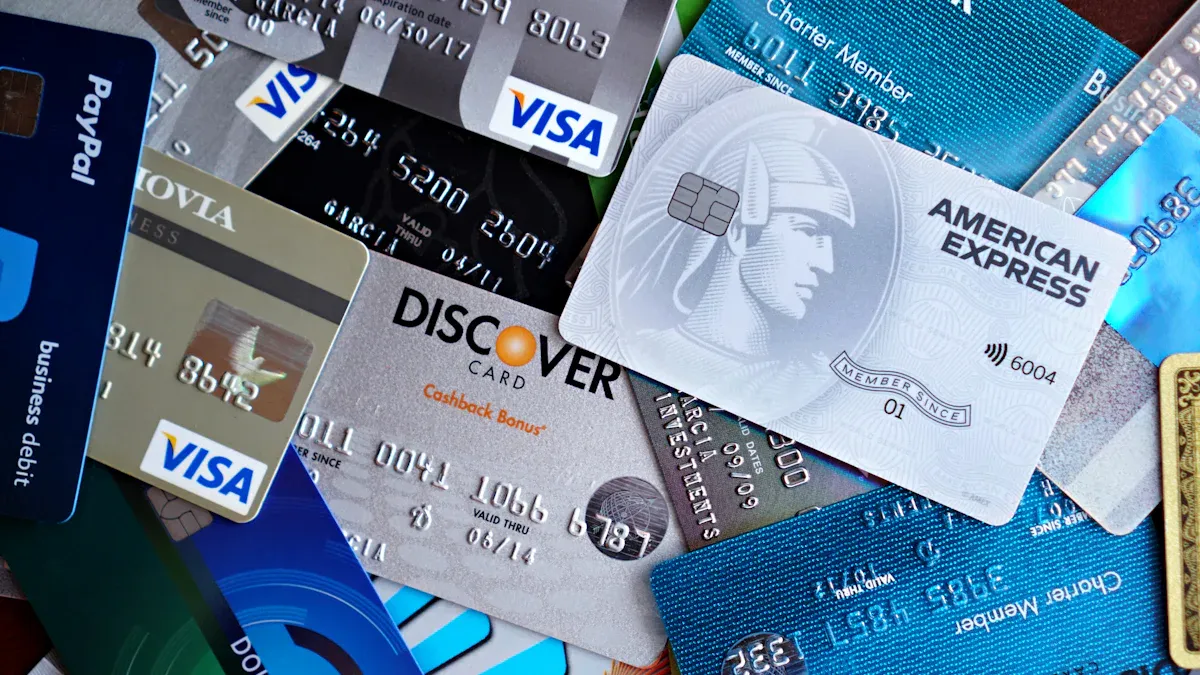- EasyCard
- Trade
- Help
- Announcement
- Academy
- SWIFT Code
- Iban Number
- Referral
- Customer Service
- Blog
- Creator
What is a Virtual Credit Card? Comparison of Advantages and Disadvantages of U.S. Platforms

Image Source: unsplash
You can think of a virtual credit card as a type of credit card that exists only online. Unlike traditional credit cards, you don’t need a physical card; you simply generate a card number through a platform for use. Virtual credit cards make online payments safer, reducing the risk of information leaks. When shopping internationally or subscribing to services, you can enjoy greater convenience and flexibility. Many cross-border users and developers are choosing virtual credit cards to meet diverse needs.
Key Points
- A virtual credit card is a credit card that exists only online, without a physical card, designed specifically for online payments, offering high security and easy management.
- Using a virtual credit card allows you to flexibly set spending limits and validity periods, effectively preventing unauthorized charges, making it suitable for cross-border shopping and subscribing to overseas services.
- Both U.S. banks and third-party platforms offer virtual credit card services; when choosing, you should focus on security, fees, currency support, and funding methods.
- Virtual credit cards are ideal for subscribing to overseas streaming services, online shopping, binding advertising accounts, and enterprise bulk management, improving payment efficiency and fund security.
- When using a virtual credit card, you should choose a compliant platform, pay attention to fund security, set reasonable spending limits, and regularly check your account to ensure worry-free fund safety.
Virtual Credit Card Overview

Image Source: unsplash
Definition
You can view a virtual credit card as a credit card designed specifically for online payments. It has no physical card, and all information exists in digital form. After applying, the platform generates a card number, expiration date, and security code for you. This information is similar to that of a traditional credit card, but you can only use it online. You can use a virtual credit card to shop, subscribe to services, or bind accounts on international platforms in the U.S., Europe, and elsewhere. Many platforms allow you to customize the card’s spending limit and validity period, enhancing payment security.
Tip: When using a virtual credit card, you don’t need to worry about losing a physical card or unauthorized charges. As long as you protect the card number and security code, you can effectively prevent information leaks.
Key Differences
Virtual credit cards and traditional credit cards have several notable differences:
- You don’t need a physical card; all operations are completed online.
- You can generate a unique card number for each transaction, reducing the risk of unauthorized charges.
- You can flexibly set spending limits and validity periods, making budget management easier.
- When making cross-border payments, virtual credit cards support multi-currency settlements, suitable for users who frequently shop in the U.S. or other countries.
The table below summarizes the main differences between virtual and traditional credit cards:
| Feature | Virtual Credit Card | Traditional Credit Card |
|---|---|---|
| Physical Card | No | Yes |
| Application Method | Online | Online or offline |
| Security | High, customizable limits | Moderate |
| Usage Scenarios | Online payments, international shopping | Online and offline |
| Multi-Currency Support | Supported | Partially supported |
You can choose the appropriate credit card type based on your needs. If you frequently shop on U.S. platforms, a virtual credit card will make your payment experience safer and more flexible.
Advantages and Disadvantages of Virtual Credit Cards
Advantages
When using a virtual credit card, you can experience several benefits:
- High security. You can generate a unique card number for each payment, reducing the risk of information leaks. Even if a card number is compromised, it won’t affect your main account.
- High convenience. You can apply for and manage it online without waiting for a physical card to be mailed. You can generate, freeze, or delete cards at any time.
- Bypassing regional restrictions. You can easily subscribe to U.S. or other overseas services like ChatGPT Plus, OpenAI API, or Amazon from China. Virtual credit cards help address limitations with traditional bank cards for USD payments.
- Multi-currency support. You can pay in USD, EUR, and other currencies, suitable for cross-border shopping and international services.
- Diverse funding methods. Some platforms support Alipay or WeChat funding, eliminating the need to purchase cryptocurrency, with low funding thresholds and a simple process.
Tip: When using a virtual credit card, you can flexibly set spending limits and validity periods, effectively managing your budget and enhancing payment security.
Disadvantages
When choosing a virtual credit card, you should also be aware of the following drawbacks:
- Some platforms require annual fees or funding transaction fees. For example, some platforms charge an annual fee of USD 10 (1 USD ≈ 7.2 CNY), and funding may incur a percentage-based fee.
- Limited functionality. You cannot use virtual credit cards for cash withdrawals, offline swiping, or in-person transactions. All transactions must be completed online.
- Significant regional restrictions. Some platforms only support users in specific countries or regions. You can only use them on third-party services permitted by the issuer, not for all goods and services.
- Transaction amount limits. Your spending per transaction cannot exceed the account balance, and there are daily transaction number and amount caps.
- Compliance risks. You must comply with the issuer’s and service provider’s regulations and cannot use the card for illegal activities, or the platform may suspend or cancel your card.
Applicable Scenarios
You can leverage the advantages of virtual credit cards in the following scenarios:
- Subscribing to overseas services. You can use a virtual credit card to subscribe to U.S. streaming services, AI tools, or developer APIs, improving payment success rates.
- Online shopping. When shopping on international e-commerce platforms like Amazon or eBay, you can use a virtual credit card for payments, supporting multi-currency settlements.
- Binding advertising accounts. You can use a virtual credit card to bind Google Ads, Facebook Ads, or other advertising accounts, facilitating business promotions.
- Protecting privacy. When shopping on untrusted websites, you can use a one-time virtual card number to reduce the risk of unauthorized charges.
- Enterprise bulk management. You can generate individual cards for employees or projects, facilitating corporate financial management and budget control.
Comparison of U.S. Virtual Credit Card Platforms

Image Source: pexels
Bank Platforms
When choosing a virtual credit card, you can consider services offered by U.S. local banks and Hong Kong banks. Major U.S. banks like Capital One, Citibank, Wells Fargo, American Express, U.S. Bank, and J.P. Morgan have introduced virtual credit card products. The table below summarizes the main features and target users of these bank platforms:
| Bank Name | Virtual Credit Card Target Users | Main Service Features | Usage Restrictions or Notes |
|---|---|---|---|
| Capital One | Individual users | Generate virtual cards via the Eno plugin; available to all Capital One credit card users, no extra fees, supports instant generation and use. | Requires computer operation and plugin installation. |
| Citibank | Select credit card users | Available only to select credit card users (e.g., Double Cash, Strata Premier); generate virtual cards after registering on the website, with a validity period of up to 12 months. | Limited to select card users. |
| Wells Fargo | All users | Generate electronic card numbers via digital wallets, supporting Google Pay, Apple Pay, etc., usable in physical stores, no extra fees. | Usable by phone unlockers, posing security risks. |
| American Express | Business users | Only for business credit card users, supports creating virtual cards for employees, facilitating expense management and reimbursement, usable online and offline. | Limited to business users. |
| U.S. Bank | Business users | Only for business users, requires phone application or online form submission for staff contact, supports one-time virtual cards for supplier payments and travel purchases. | Limited to business users. |
| J.P. Morgan | Business users | Only for business users, requires online form submission for staff contact, provides virtual card services. | Limited to business users. |
If you are in China or other countries and want to apply for a U.S. bank’s virtual credit card, you typically need a U.S. local identity or company credentials. Some Hong Kong banks also offer similar services, but they primarily target business clients, making it challenging for individual users to apply.
Third-Party Platforms
You can also choose third-party virtual credit card platforms, which are generally more user-friendly for international users, supporting multiple currencies and funding methods. Common U.S. and international third-party platforms include Privacy.com, Wise, Ramp, Skrill, WildCard, OneKey Card, HoneyCard, NOBE, RIAT, YEKA, and FOTONCARD.
Different platforms vary significantly in currency and funding methods. For example, the SKYEE platform requires that each payment account key corresponds to a specific currency. When funding, you must ensure the funding currency matches the supported account currency, or it may be rejected or incur additional conversion fees. SKYEE only supports electronic fund transfers and does not accept cash, checks, debit cards, or credit card funding. Each account credential supports different transfer methods, and you need to choose a supported method, or the transfer may be rejected. Additionally, the platform reserves the right to decide whether to accept funds without explanation, reflecting the flexibility and limitations of third-party platforms in funding and currency support.
Some platforms, such as NOBE, RIAT, YEKA, and FOTONCARD, support funding via Alipay, WeChat, cryptocurrency, and other methods, making them suitable for Chinese and international users. You can choose a platform supporting USD, EUR, or other currencies based on your needs for convenient cross-border consumption.
Feature Comparison
When choosing a virtual credit card platform, you should focus on the following core features:
- Security: Bank platforms typically rely on their own risk control systems, offering high security. Third-party platforms like Privacy.com and Wise also provide one-time card numbers and spending limit functions to effectively prevent unauthorized charges.
- Fees: Most U.S. bank platforms don’t charge extra fees, but application thresholds are high. Some third-party platforms are free, while others charge annual or funding fees. For example, NOBE charges an annual fee of about USD 10 (1 USD ≈ 7.2 CNY), with funding fees based on a percentage.
- Currency Support: Bank platforms mainly support USD, with some supporting multiple currencies. Third-party platforms offer broader currency options, suitable for users with multi-currency needs.
- Funding Methods: Bank platforms typically only support local bank transfers. Third-party platforms support Alipay, WeChat, cryptocurrency, and international wire transfers, offering more flexible funding.
- Unlimited Card Issuance: Some third-party platforms support generating unlimited virtual card numbers, ideal for enterprise bulk management and personal multi-scenario use. Bank platforms generally limit the number of cards.
- Target Users: Bank platforms are more suitable for U.S. local users or businesses. Third-party platforms are more accessible to Chinese and international users, available to both individuals and businesses.
Tip: When choosing a platform, prioritize security and compliance, and select one that supports suitable currencies and funding methods based on your needs.
Applications and Precautions
Common Applications
You can use a virtual credit card in many scenarios. For example, if you want to shop on e-commerce platforms in the U.S. or other countries, you can use it to make payments in USD or EUR. If you want to subscribe to Netflix, Spotify, ChatGPT Plus, or other overseas services, you can also use a virtual credit card to bind accounts for seamless deductions.
If you are a developer registering for a Google Developer account, you typically need to pay a USD 25 (1 USD ≈ 7.2 CNY) registration fee. You can follow this process:
- Quickly obtain a virtual credit card through a card-issuing platform, completing the process in minutes.
- Fund the card to ensure sufficient balance.
- Use the virtual credit card to pay the fee during Google Developer platform registration.
- To prevent account bans, use a dedicated VPS, change IPs, prepare fresh information, and ensure one card per account.
- You can also add the virtual credit card to Apple Pay, Google Pay, or other platforms for convenient online payments and subscriptions.
Additionally, businesses can use virtual credit cards for bulk management of advertising accounts like Google Ads or Facebook Ads, facilitating financial control. Cross-border e-commerce sellers also commonly use virtual credit cards to settle international orders, improving fund turnover efficiency.
Usage Recommendations
When using a virtual credit card, you need to pay special attention to fund security and platform compliance. Compliant platforms adhere to the Payment Card Industry Data Security Standard (PCI DSS), such as installing firewalls, encrypting transmitted data, restricting access, and regularly updating security patches. Platforms do not store sensitive authentication data like CVV codes or PINs, often using tokenization to protect your account information.
When choosing a platform, it’s recommended to prioritize service providers with PCI compliance credentials. Hong Kong banks and major international platforms generally offer higher security guarantees. When funding, verify the currency to avoid extra fees due to mismatches.
If you need a refund, check the platform’s refund policy and processing time in advance. Some platforms support funding via Alipay, WeChat, cryptocurrency, and other methods, but processing speeds and fees may vary. You should keep transaction records and contact customer service promptly if issues arise.
Tip: Choosing a compliant platform, setting reasonable spending limits, and regularly checking account balances can effectively reduce risks and ensure fund security.
You can experience the following benefits in actual use:
- Immediate use upon approval, no need to wait for card production or mailing.
- Secure information, with some platforms supporting one-time card numbers to reduce unauthorized charge risks.
- No physical card to lose, and you can retrieve the card number by logging into your account.
- Flexible spending limits to help control expenses.
- Convenient management of free trial services, avoiding automatic deductions after trial periods.
- Easy operations, with some Hong Kong banks and U.S. platforms supporting plugins for instant card number generation, locking, or deletion.
- Refunds can be returned to the credit card account if you comply with the policy.
When choosing a platform, you should focus on security, fees, currency, and funding methods. Different platforms suit different needs. You can rationally choose the appropriate payment tool based on your specific scenarios.
FAQ
How do I apply for a virtual credit card?
You can register an account on a third-party platform or Hong Kong bank website and submit identity information to apply. Some platforms support Chinese users, and upon approval, you’ll receive a card number and security code.
What are the funding methods for a virtual credit card?
You can fund it via Alipay, WeChat, cryptocurrency, or international wire transfers. Some platforms support USD funding, with 1 USD ≈ 7.2 CNY. Confirm the platform’s supported currencies and methods before funding.
Can I get a refund with a virtual credit card?
When requesting a refund, the platform will return the amount to the original virtual credit card account. Processing times vary by platform, typically 1-7 business days. Check the platform’s refund policy in advance.
Are virtual credit cards safe?
You can generate a unique card number for each transaction and set spending limits, effectively preventing unauthorized charges. Compliant platforms use encryption to protect your account information.
What scenarios are virtual credit cards suitable for?
You can use virtual credit cards to subscribe to overseas services, shop online, bind advertising accounts, or register developer accounts. Businesses can also use them for bulk employee expense management, improving financial efficiency.
You have gained a comprehensive understanding of virtual credit cards, including their definition, pros and cons, and a comparison of major U.S. platforms. This guide provides a detailed look at how to use virtual credit cards for secure and convenient online payments, making it a highly practical tool, especially for cross-border consumers and those subscribing to overseas services.
However, in practice, you might find that virtual credit cards still have some limitations. For example, many platforms require you to top up your card via bank wire transfers or specific payment methods, which can be a complex and costly process for users located in China or those without a U.S. bank account. Additionally, if you need to handle large fund transfers or want to flexibly exchange between different currencies to save on exchange rate costs, the features of virtual credit card platforms might not fully meet your needs.
To solve these challenges, we recommend a more comprehensive and flexible global financial service platform: BiyaPay. BiyaPay offers ultra-low transfer fees as low as 0.5% and supports same-day remittance and arrival, greatly simplifying your cross-border fund management. Whether you need to convert HKD or USD to other fiat currencies or want to conduct fast, low-cost exchanges between USD, HKD, and cryptocurrencies, BiyaPay provides a secure and transparent service. You can also use its real-time exchange rate lookup to complete transactions at the best possible rate. Register now to begin your new global financial journey.
*This article is provided for general information purposes and does not constitute legal, tax or other professional advice from BiyaPay or its subsidiaries and its affiliates, and it is not intended as a substitute for obtaining advice from a financial advisor or any other professional.
We make no representations, warranties or warranties, express or implied, as to the accuracy, completeness or timeliness of the contents of this publication.




Contact Us
Company and Team
BiyaPay Products
Customer Services
is a broker-dealer registered with the U.S. Securities and Exchange Commission (SEC) (No.: 802-127417), member of the Financial Industry Regulatory Authority (FINRA) (CRD: 325027), member of the Securities Investor Protection Corporation (SIPC), and regulated by FINRA and SEC.
registered with the US Financial Crimes Enforcement Network (FinCEN), as a Money Services Business (MSB), registration number: 31000218637349, and regulated by FinCEN.
registered as Financial Service Provider (FSP number: FSP1007221) in New Zealand, and is a member of the Financial Dispute Resolution Scheme, a New Zealand independent dispute resolution service provider.




















